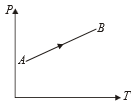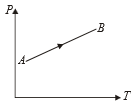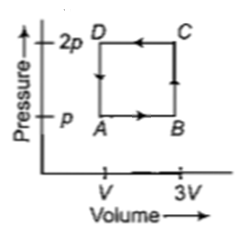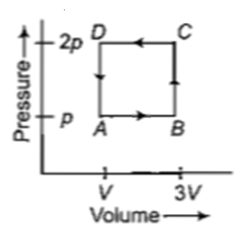Two samples A and B of a gas initially at the same pressure and temperature are compressed from volume V to V/2 (A isothermally and B adiabatically). The final pressure of A is
(1) Greater than the final pressure of B
(2) Equal to the final pressure of B
(3) Less than the final pressure of B
(4) Twice the final pressure of B
एक गैस के दो नमूने A और B प्रारंभ में समान दाब और तापमान पर आयतन V से V/2 तक (A समतापी विधि से और B रुद्धोष्म विधि से) संपीडित किए जाते है। A का अंतिम दाब है:
(1) B के अंतिम दाब से अधिक है
(2) B के अंतिम दाब से बराबर है
(3) B के अंतिम दाब से कम है
(4) B के अंतिम दाब से दो गुना है
A thermodynamic process is shown in the figure. The pressures and volumes corresponding to some points in the figure are : and . In process AB, 600 J of heat is added to the system and in process BC, 200 J of heat is added to the system. The change in internal energy of the system in process AC would be
(1) 560 J
(2) 800 J
(3) 600 J
(4) 640 J
एक ऊष्मागतिकीय प्रक्रम को चित्र में दिखाया गया है। चित्र में कुछ बिंदुओं के संगत दाब और आयतन हैं: और । AB प्रक्रम में, 600 J ऊष्मा प्रदान की जाती है और BC प्रक्रम में 200 J ऊष्मा प्रदान की जाती है। प्रक्रम AC में निकाय की आंतरिक ऊर्जा में परिवर्तन होगा:
(1) 560 J
(2) 800 J
(3) 600 J
(4) 640 J
Thermodynamic process are indicated in the following diagram
Match the following:
column-I column-II
P. Process-I (a) Adiabatic
Q. Process-II (b) Isobaric
R. Process-III (c) Isochoric
S. Process-IV (d) Isothermal
(a)
(b)
(c)
(d)
ऊष्मागतिक प्रक्रम निम्न आरेख में इंगित किये गए हैं
निम्नलिखित को मिलाएं:
स्तंभ-I स्तंभ-II
P. प्रक्रम- I (a) रुद्धोष्म
Q. प्रक्रम- II (b) समदाबीय
R. प्रक्रम- III (c) समआयतनिक
S. प्रक्रम- IV (d) समतापीय
(a)
(b)
(c)
(d)
A cyclic process ABCD is shown in the P-V diagram. Which of the following P-T curves represent the same process ?
(1)
(2)
(3)
(4)
P-V आरेख में एक चक्रीय प्रक्रम ABCD दिखाया गया है। निम्नलिखित में से कौन-सा P-T वक्र समान प्रक्रम प्रदर्शित करता है?
(1)
(2)
(3)
(4)
The variation of pressure versus temperature of an ideal gas is shown in the given diagram. From this diagram, one can conclude that

1. Volume increases continuously
2. Volume decreases continuously
3. Volume first increases then decreases
4. Volume first decreases, then increase
एक आदर्श गैस के दाब व तापमान के परिवर्तन को दिए गए आरेख में दिखाया गया है। इस आरेख से, यह निष्कर्ष निकाला जा सकता है कि:

1. आयतन लगातार बढ़ता है
2. आयतन लगातार घटता है
3. आयतन पहले बढ़ता है, फिर घटता है
4. आयतन पहले घटता है, फिर बढ़ता है
A sink, that is the system where heat is rejected, is essential for the conversion of heat into work. From which law the above inference follows?
(1) zeroth
(2) First
(3) Second
(4) Third
एक अभिगम, वह निकाय है जहां ऊष्मा को निष्काषित कर दिया जाता है, ऊष्मा को कार्य में परिवर्तित करने के लिए आवश्यक है। उपरोक्त निष्कर्ष किस नियम का अनुसरण करता है?
(1) शून्य
(2) प्रथम
(3) द्वितीय
(4) तृतीय
The temperature inside a refrigerator is and the room temperature is . The amount of heat delivered to the room for each joule of electrical energy consumed ideally will be -
1.
2.
3.
4.
एक प्रशीतक/रेफ्रिजरेटर के अंदर का तापमान है और कमरे का तापमान है। आदर्श रूप से प्रयुक्त विद्युत ऊर्जा के प्रत्येक जूल के लिए कमरे को प्रदत्त ऊष्मा की मात्रा होगी -
1.
2.
3.
4.
In the figure given two processes A and B are shown by which a thermo-dynamical system goes from initial to final state F. If ΔQA and ΔQB are respectively the heats supplied to the systems then
(1) ΔQA = ΔQB
(2)
(3) ΔQA < ΔQB
(4) ΔQA > ΔQB
चित्र में दो प्रक्रम A और B दर्शाए गए हैं जिनके द्वारा एक ऊष्मागतिक निकाय प्रारंभ से अंतिम स्थिति F में जाता है। यदि ΔQA और ΔQB क्रमशः निकाय को दी गयी ऊष्माएँ है तब
(1) ΔQA = ΔQB
(2)
(3) ΔQA < ΔQB
(4) ΔQA > ΔQB
A refrigerator works between 4°C and 30°C. It is required to remove 600 calories of heat every second in order to keep the temperature of the refrigerated space constant. The power required is (Take, 1 cal = 4.2 Joules)
(a)23.65W
(b)236.5W
(c)2365W
(d)2.365W
एक फ्रिज 4°C और 30°C के बीच कार्य करता है। इसे प्रशीतित स्थान के तापमान को नियत रखने के लिए
प्रत्येक सेकंड 600 कैलोरी ऊष्मा को निष्काषित करना आवश्यक है। आवश्यक शक्ति है (1 कैलोरी = 4.2 जूल लीजिए)
(a) 23.65W
(b) 236.5W
(c) 2365W
(d) 2.365W
A thermodynamic system is taken through the cycle ABCD as shown in figure. Heat rejected by the gas during the cycle is

(a)2 pV (b)4 pV
(c) (d)pV
चित्र में दिखाए अनुसार एक ऊष्मागतिकी निकाय चक्र ABCD के माध्यम से लाया गया है। चक्र के दौरान गैस द्वारा निष्काषित ऊष्मा है:

(a) 2 pV (b) 4 pV
(c) (d) pV














